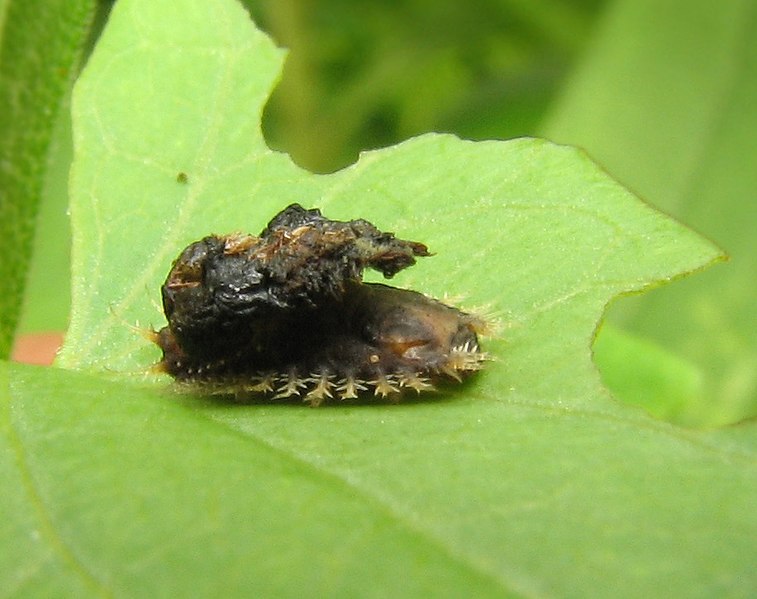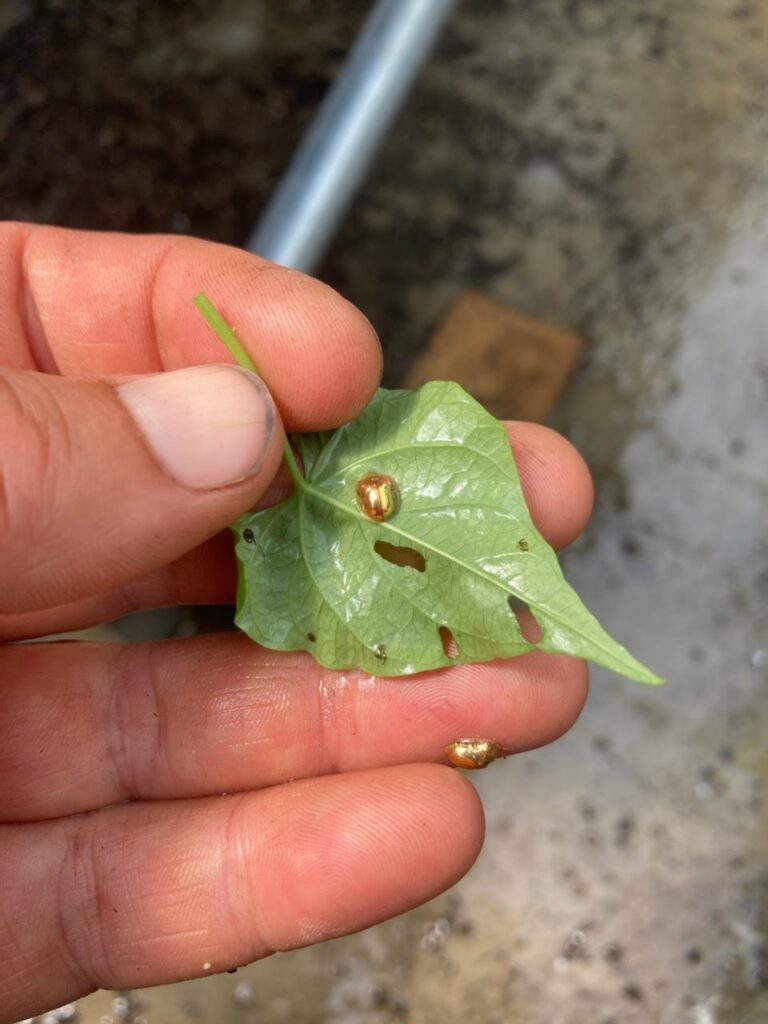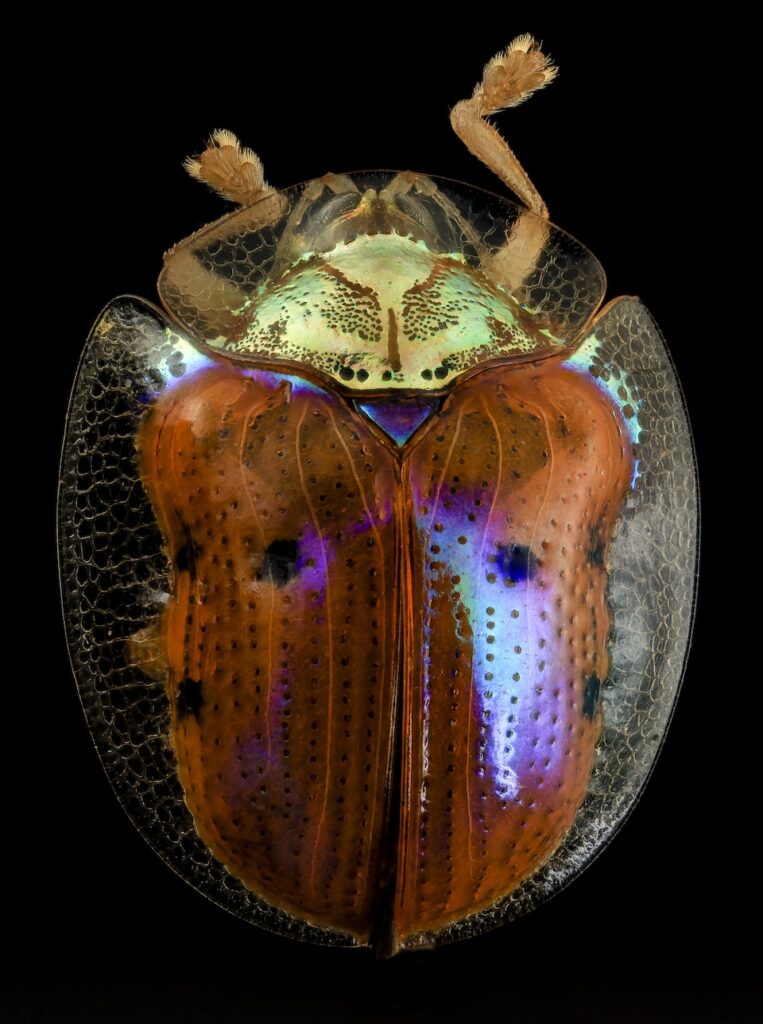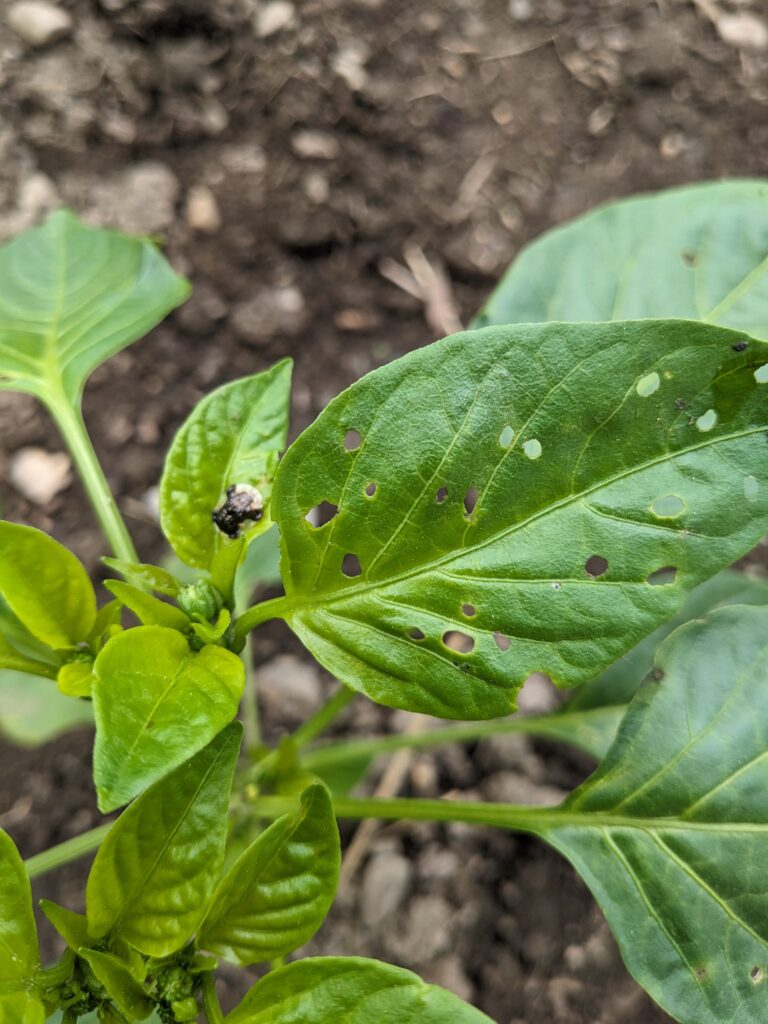
Pest: Tortoise beetle (species in the Cassidinae subfamily)
Pest/disease identification and lifecycle, most common damage symptoms and crops affected:
There are many species of tortoise beetles globally but only two that are commonly noticed in Maine: clavate tortoise beetle (Plagiometriona clavata) and golden tortoise beetle (Charidotella sexpunctata). Adult tortoise beetles lay their eggs on the undersides of leaves on host plants. Larvae that hatch out protect themselves with a “fecal shield,” built upon their “anal fork,” which they can raise up against potential predators (Fig. 1).


Clavate tortoise beetles feed exclusively on solanaceous plants. They are oval to square in shape, clear to slightly metallic looking with a dark square marking on the center of their back. Once you see one you will remember it — some describe the dark marking as looking like a teddy bear (click Fig. 4 to enlarge image). Overwintered adults come out in the mid- to late-spring, and begin feeding and laying eggs. This overwintered generation is likely the most noticeable, as their minor feeding damage looks more dramatic on smaller late-spring plants. Larvae will feed on the same plants, and their presence may overlap with the overwintered generation.
Golden tortoise beetles have a very similar lifecycle, but feed exclusively on plants in the Convolvulaceae (morning glory) family. As the common name suggests, golden tortoise beetles often appear to literally be made of shiny gold, and are sometimes called “gold bugs” as well (Fig. 2). These beetles have a remarkable color-changing ability and may hide their metallic gold coloration and appear orange to red with black dots at some points in their development or when disturbed (see Fig. 3). The golden sheen also disappears after death, disappointing would-be collectors, jewelry makers, etc.
Here in Maine, both species of tortoise beetle are expected to only produce one generation per year. Development from egg to adult stage probably takes around six weeks for both species. After larvae pupate and emerge as adults, they will feed a little bit and then enter diapause, not becoming active again until the following spring. Further south, both species may produce two or more generations in a season.

The red and black coloration is a stress response as the result of being disturbed, likely a defence against predation. Courtesy of U.S. Geological Survey
Department of the Interior/USGS Bee Inventory and Monitoring Lab, Beltsville, Maryland
Damage and crops affected:
Damage from both species of tortoise beetle is typically minor and limited to small holes chewed through leaves of their host plants. Clavate tortoise beetles feed on plants in the Solanaceae family and may be found on peppers, eggplants, ashwagandha, tomatillos, potatoes, tomatoes, datura, solanaceous weeds, etc. Golden tortoise beetles feed on plants in the Convolvulaceae family and may be found on sweet potatoes, morning glory, moonflower, Ipomoea lobata, bindweed, etc.
Management options:
Most commonly, these beetles are a minor pest — more of a curiosity than a concern. They do not usually build up a large enough population to cause serious damage and do not warrant spraying. When in small numbers you can ignore them, as they are unlikely to cause enough damage to affect yields. In small growing areas the beetles can be easily managed by hand. Golden tortoise beetle can sometimes be considered a larger problem — though only if you are concerned about aesthetic damage on foliage. Small holes in leaves of food crops will likely not affect yields or marketability of edible portions (with the exception of sweet potato greens). In very rare situations where populations are substantial over a larger growing area, both species are susceptible to common organic pesticides.
While both species have the ability to fly, neither are overly active fliers and clavate tortoise beetles rarely do so after finding a preferred host plant.
Scouting:
Pro-active scouting is not typically recommended because of the rarity of significant damage from these species. If a population will build up to a great enough extent to cause real damage, the damage itself will likely be the instigator and primary target of any scouting. Both adults and larvae can be found feeding on the underside of leaves, where eggs are also laid, but adults may also be seen feeding on the topside of leaves. Because they typically chew holes all the way through a leaf, feeding damage is easily visible and sometimes the first noticeable sign of their presence (Fig. 4).
Cultural:
Tortoise beetles could be easily excluded with row cover or exclusion netting applied before their emergence, or relatively easily removed by hand or with a handheld vacuum in smaller growing areas. Similarly, eggs of the next generation can be easily squished when checking leaf undersides.
Biocontrol options:
Both species are likely to be preyed upon by several common insect predators, and their presence may even be a net positive in terms of their role as prey to wild populations of predators and parasitoids. Possible predators include spiders, lady beetle species, and predatory bug species (e.g., assassin bug, damsel bug, spined soldier bug). Golden tortoise beetles have been reported as hosts of the parasitoid wasp Tetrastichus cassidis, and the parasitoid fly Eucelatoriopsis dimmocki.

Organic pesticides (as a last resort):
Larval stages of tortoise beetles are likely susceptible to pesticides containing azadirachtin (the active ingredient derived from neem). Adults and larvae are likely susceptible to pyrethrin-containing pesticides (e.g., PyGanic). Entomopathogenic fungi based materials (e.g., products containing Beauveria bassiana, like Mycotrol ESO among several other brands) may also put a dent in their populations if applied more than once, and when conditions are favorable (i.e., low sunlight and/or gentle wet weather).
Please note: This information is for educational purposes. Any reference to commercial products, trade or brand names is for information only, and no endorsement or approval is intended. Pesticide registration status, approval for use in organic production and other aspects of labeling may change after the date of this writing. It is always best practice to check on a pesticide’s registration status with your state’s board of pesticide control, and for certified organic commercial producers to update their certification specialist if they are planning to use a material that is not already listed on their organic system plan. The use of any pesticide material, even those approved for use in organic production, carries risk — be sure to read and follow all label instructions. The label is the law. Pesticides labeled for home garden use are often not allowed for use in commercial production unless stated as such on the label.
Authors
Caleb Goossen
Source material:
https://edis.ifas.ufl.edu/publication/IN140
https://animaldiversity.org/accounts/Plagiometriona_clavata
https://entomologist.net/beetles/100-charidotella-sexpunctata.html